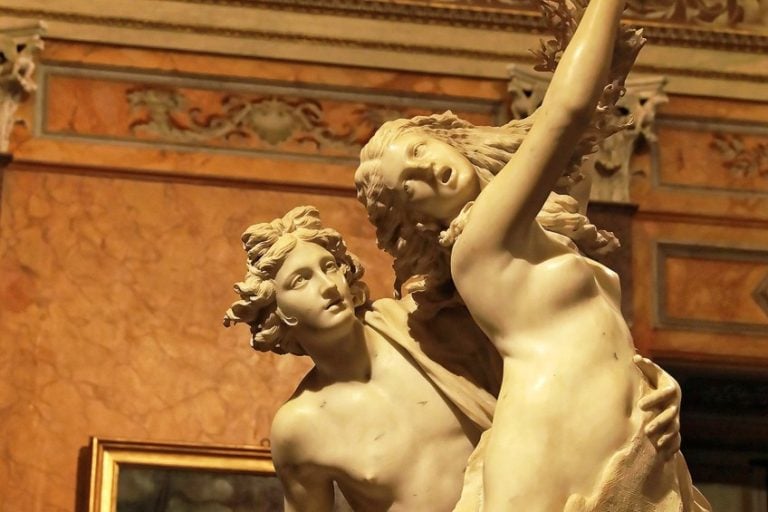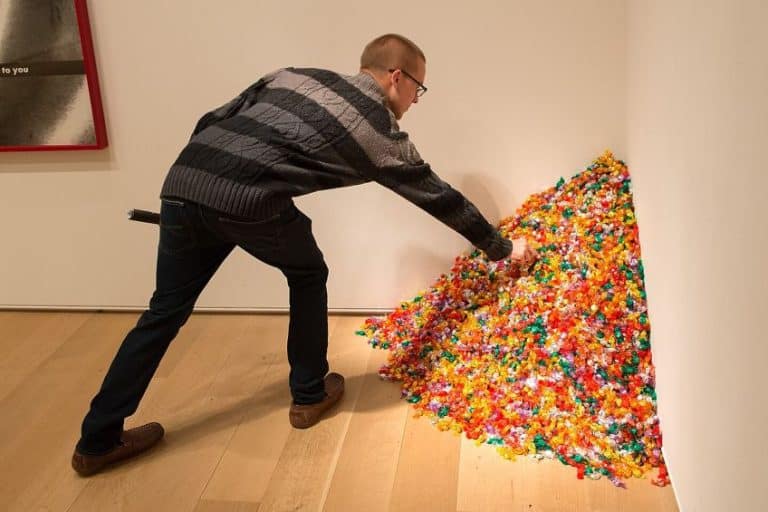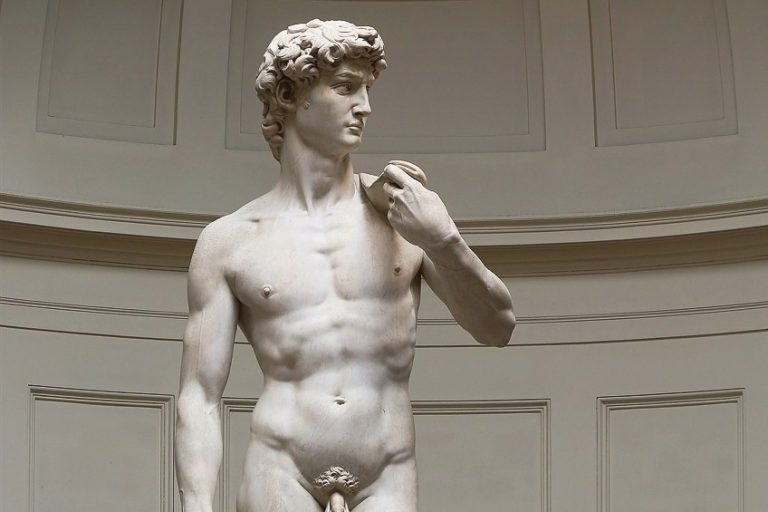“The Kiss” Sculpture by Auguste Rodin – Analyzing Rodin’s “The Kiss”
Many Auguste Rodin sculptures have achieved great fame, such as The Thinker (1880). However, unlike The Thinker, which epitomizes thought and rationality, The Kiss (c. 1882) portrays burning desire and passion. Although it was outrageous when first exhibited in 1887, the public could not get enough of it, and neither can we. This article explores the fascinating and seldom told story of Rodin’s The Kiss.
Table of Contents
- 1 The Kiss Statue by Auguste Rodin
- 2 Analyzing Auguste Rodin’s The Kiss Statue
- 3 Interesting Facts About Auguste Rodin’s The Kiss Statue
The Kiss Statue by Auguste Rodin
The Kiss sculpture by Auguste Rodin is considered to be one of the most romantic sculptures in the Western world. The sculpture, which shows two nude figures in an embrace, shocked the public upon its release in 1887. Although it is no longer controversial it is still frequently spoken about today.
Many different versions of the sculpture can be seen in famous museums and art galleries worldwide.
A Brief Look at Auguste Rodin
| Nationality | French |
| Date of Birth | 12 November 1840 |
| Date of Death | 10 November 1917 |
| Place of Birth | Paris, France |
Born François Auguste René Rodin in 1840, Rodin belonged to a working-class family. He was educated at the Petite École, at which he received lessons in arts and mathematics. It was here that he received the majority of his formal artistic training. After finishing at the Petite École, Rodin applied to the École des Beaux-Arts to study sculpture. However, he was turned away three times, which was a great knock to his ego.
In order to make a living, Rodin began working as an artisan, sculpting ornamental pieces for architecture.
In 1866, Albert-Ernest Carrier-Belleuse, a producer of objets d’arts, hired Rodin as his assistant. Under his employment, Rodin continued to create architectural ornaments, such as roof and door adornments. The two worked well together until 1870 when the Franco-Prussian War began.

Rodin was conscripted into the French National Guard, however, due to his poor eye-sight they did not keep him long. After returning from the army, he found that there were very few job opportunities for him during the war. Thus, he decided to follow Carrier-Belleuse to Belgium where they worked on designing and sculpting the ornamentation for the Brussels Stock Exchange.
Over time, their relationship began to deteriorate and they decided to part ways. Rodin had intended on staying in Belgium only long enough for the war to end. However, he ended up staying for almost six years.
In 1875, Rodin took a trip to Italy where he visited numerous art galleries and museums. He became awestruck by the sculptures of Michelangelo, particularly those which were unfinished. He loved Michelangelo’s belief that “every block of stone has a statue in it and it is the task of the sculptor to discover it.” This was a major influence on his raw, uncompleted style. Upon returning to Belgium, he set to work on one of his more controversial sculptures, The Bronze Age (1877).

In 1880, looking to reconcile, Carrier-Belleuse offered him a job designing ceramics for the Sévres national porcelain factory. It is here that his career as an artist really began. Not only did he help popularize the Sévres national porcelain factory, some of the pieces he created even got displayed at the Paris Salon. This earned him a great deal of respect in the art community.
Being part of the social circle of Parisian artists also allowed him to network and gain sculpting commissions.
One such commission was given to him by Edmund Turquet, the Undersecretary of the Ministery of Fine Arts. Rodin was commissioned to create an elaborate entrance to the Decorative Arts Museum. He had a great deal of artistic freedom and it was up to him to decide what the theme for the entrance would be. Rodin chose to base the doors on Dante’s Inferno (1314), naming them The Gates of Hell (1917). Many of his most famous sculptures, such as The Thinker (1880) and The Kiss were originally designed as part of The Gates of Hell.

Rodin did not manage to complete The Gates of Hell before his passing in 1917. However, this was not a problem as the Decorative Arts Museum was never actually built. The various casts made for the doors are now displayed in famous museums around the world such as the Musée d’Orsay, Paris; the Rodin Museum, Pennsylvania; and the National Museum of Western Art, Tokyo.
At the beginning of 1917, Rodin finally married the mother of his child and his lifelong companion Rose Beuret. They did not always have an easy relationship and Beuret had stuck with Rodin through many affairs and scandals. Unfortunately, she died two weeks after their wedding. Rodin became ill shortly after her passing, and in November of the same year succumbed to influenza.
Rodin’s dying wish was that a cast of his statue “The Thinker” be used in place of a tombstone on his grave.
His tomb and the cast can still be found at his home in Meudon, just outside of Paris, which has now been converted into a museum. In 1919, the Hôtel Biron, in Paris where Rodin once lived was also converted into the Musée Rodin. He left the majority of his molds to the French government with permission to cast them. Therefore, Rodin statues can be found in multiple places in France as well as around the world.

Analyzing Auguste Rodin’s The Kiss Statue
| Date Completed | c. 1882 |
| Medium | Marble |
| Dimensions | 181.5 cm x 112.5 cm |
| Current Location | Musée Rodin, Paris, France |
Auguste Rodin originally intended for The Kiss to be a feature on The Gates of Hell. However, the building that The Gates of Hell was commissioned for, the Decorative Arts Museum, was never built. Rodin also never actually finished sculpting or casting The Gates of Hell during his lifetime. However, upon deciding that The Kiss did not actually make sense on the doors, Rodin turned the sculpture into a stand-alone piece.

Details
Rodin’s The Kiss shows a male and female nude caught in a moment of unbridled passion. Although the figures could be any couple, we know that Rodin based them upon Francesca and Paolo, a pair of adulterous lovers from Dante’s Divine Comedy (1320).
Francesca is leaning deeply into the kiss, suggesting that she might be the initiator.
Paolo, on the other hand, is touching her thigh only lightly, indicating that we are viewing the initial stages of the embrace. In Paolo’s other hand is a book that is supposed to be the story of Lancelot and Guinevere, which the couple was reading together.
A smaller version of The Kiss statue that we know today was first displayed in Paris in 1887. Although it was shocking, the public was fascinated by it. So much so that the French government would commission Rodin to create a larger marble version. In fact, three separate sculptures of The Kiss were commissioned during Rodin’s lifetime.

Commissions
The Kiss sculpture by Auguste Rodin achieved widespread popularity after its first exhibition in 1887. In fact, it was so well received by the public and art critics that Rodin was approached by three separate entities, each wanting their own version of The Kiss.
The French Government Commission
Auguste Rodin’s sculptures had become so reputable by the late 19th century that the French government commissioned one for their collection. After The Kiss did so well in its first exhibition in 1887, the French government requested Rodin make a larger marble version. Almost two meters high, it was intended to be displayed at the 1889 Exposition Universelle. However, the statue was only completed almost a decade later.
Thus, it made its first public appearance at the Salon de la Société Nationale des Beaux-Arts in 1898. In 1918, it was transported to its current home at the Musée Rodin.

The Warren Commission
The Kiss sculptor had gained international recognition by the early 1900s. A friend of the American art collector Edward Perry Warren saw The Kiss whilst visiting Paris. He suggested Warren try to buy it from the French government as it fitted in with the collector’s eclectic taste. However, the French government refused to sell the sculpture, urging Warren to reach out to Rodin.
Warren commissioned his own version of The Kiss statue. A lover of traditional Greek art, he requested that the male nude’s genitalia be fully actualized in his rendition. Warren’s version was completed in 1904 and shipped to his home in England.
Oddly enough, it was placed in his stables and not in the house. It is not known whether this is because Warren was unhappy with how the sculpture turned out, or if the statue simply would not fit through the doors of the house. It would be stored in the stables for the next ten years.
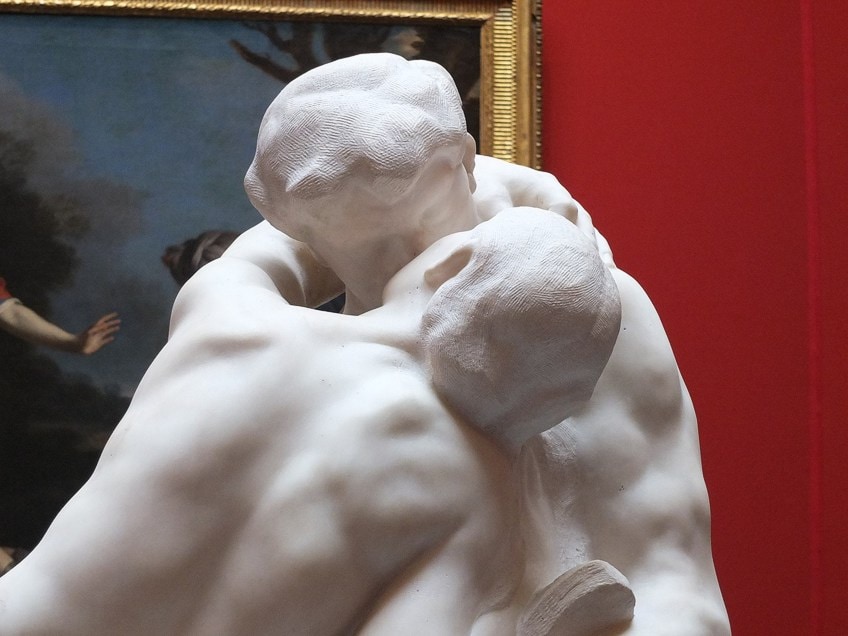
In 1914, Warren lent his version of The Kiss to the Lewes Town Hall for an exhibition. Many were unhappy with such an erotic work of art being displayed to the public. It is believed that it was not the nudity of the figures which cause offense. Rather, it was the fact that the female nude seems to be the initiator of the intimacy.
During this time, female desire was particularly taboo. However, despite the complaints, the sculpture remained there until 1917.
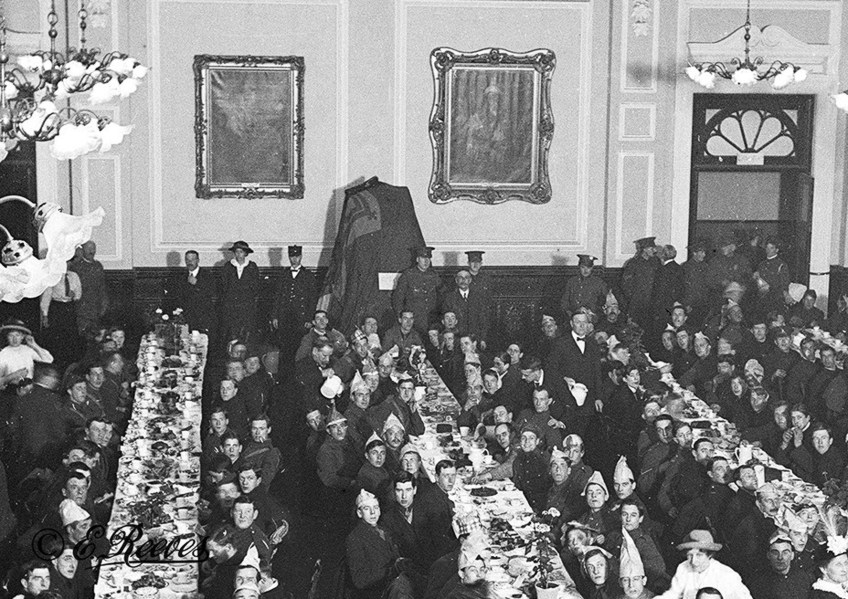
Warren died in 1928, leaving The Kiss as part of his estate. Although his estate administrators tried to sell The Kiss it would not fetch the price they were looking for. Thus, Warren’s version of The Kiss by Auguste Rodin was loaned to the Tate Gallery in London.
In 1955, the Tate decided to make it a permanent part of their collection and bought it from Warren’s estate. It is still housed there today, although it was been on loan to a number of other temporary exhibitions worldwide.
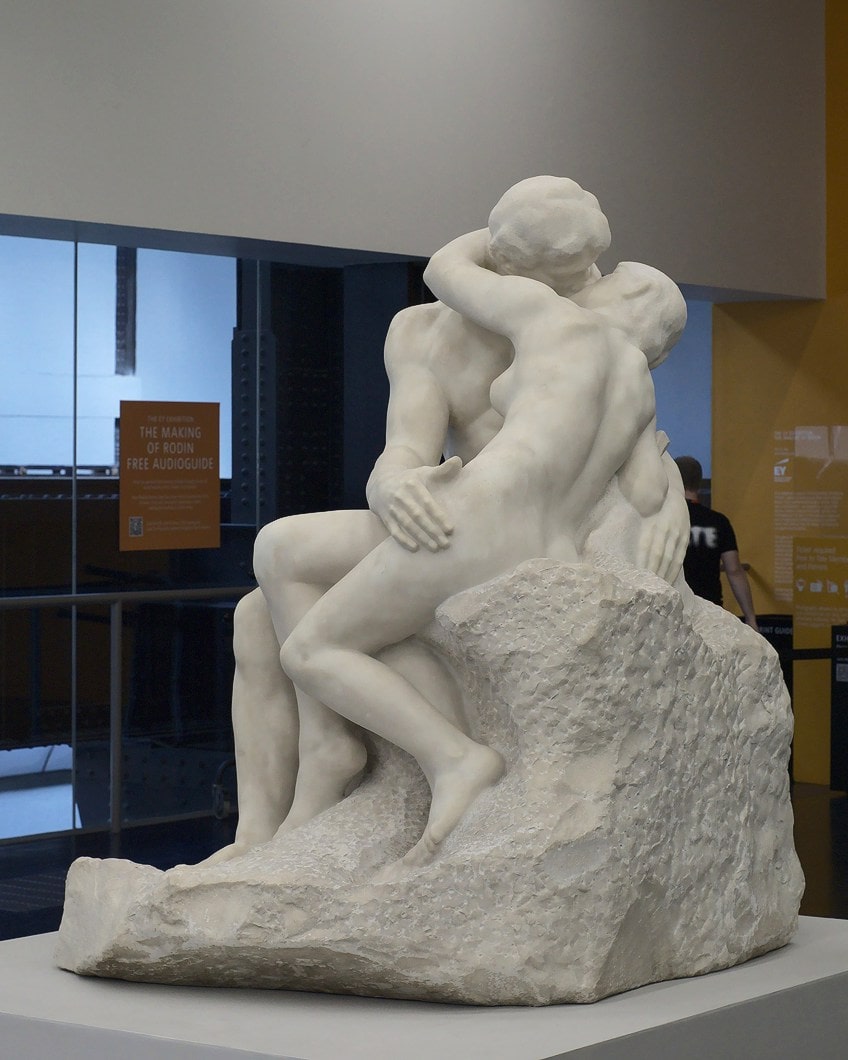
The Jacobsen Commission
Around the same time as Warren’s version was commissioned, the Danish brewer and collector of art Carl Jacobsen requested his own. Jacobsen commissioned his version of The Kiss for the Ny Carlsberg Glyptotek in Copenhagen, Denmark. Here one can find an extensive collection of both Danish and French art. Jacobsen’s The Kiss has been a permanent part of the gallery’s collection since its arrival in 1906.

Casts
Many casts of Auguste Rodin’s sculptures have been made over the years, of which The Kiss is likely the most cast. When The Kiss was first displayed in 1887, French metal company Barbedienne got permission to manufacture smaller bronze versions of the sculpture. More than 300 of these casts were produced. However, in accordance with French law, only the first 12 are considered original copies.
However, original or not, these bronze casts can be sold for up to $2.5 million today.
After Rodin’s death, the artist Henri-Léon Gréber was commissioned to make another larger copy of The Kiss, with the help of Rodin’s casts. This copy of The Kiss can be found in the Rodin Museum in Philadelphia, Pennsylvania. One of Rodin’s plaster casts can also be found in Buenos Aires, in their Museo Nacional de Bellas Artes.

Interesting Facts About Auguste Rodin’s The Kiss Statue
Everyone knows Rodin’s The Kiss by sight but very few know the actual story that surrounds this incredible sculpture. The history of its creation, as well as the events that followed, are not what one would expect of one of the world’s most famous displays of romance. Keep reading to find out some facts about The Kiss by Auguste Rodin that you probably did not know.

The Kiss Was First Called Francesca da Rimini
As has already been discussed in the article above, The Kiss sculptor had originally intended to place the pair of lovers on The Gates of Hell. It may seem like an odd choice given the romantic nature of the sculpture; however, the real story behind the lovers is far less romantic.
“The Kiss” statue is based upon real people that existed in Italy during the Middle Ages, and who feature in Dante’s “Divine Comedy”.

In the story, Francesca da Rimini belongs to a prominent Italian family. In order to stop a feud between them and the Malatesta, another influential family in the region, they promise Francesca to their oldest son, Giovanni. It is believed that Giovanni was hideous and disfigured. Thus, they prevented Francesca from seeing him until they were at the altar and she could not refuse him. During all of the wedding preparations, Giovanni’s younger brother Paolo, who was said to be very handsome, stood in for him.
It was here that Francesca’s passion for Paolo first began.
After the wedding, Francesca and Paolo were reading the story of the knight Lancelot and his love interest Guinevere. The romantic story filled Francesca with so much passion for Paolo that she could not control herself and embraced him. It was at this very moment that her husband Giovanni walked in. Filled with a jealous rage, he proceeded to stab his wife and brother to death.

The Kiss by Auguste Rodin captures the moment just before Giovanni discovers the adulterous lovers. However, many people did not understand the reference behind the sculpture, simply believing it to be a couple sharing an intimate moment. For this reason, art critics urged Rodin to rename it The Kiss.
Thus, due to its new name, even fewer people know the actual sordid tale behind the statue.
The Lovers Never Actually Kiss
Although the statue has been titled The Kiss, no actual kiss takes place. When looking closely one can see that the lips of the two figures never really meet. This was intentionally done by Rodin for a couple of reasons.
Firstly, by posing the lovers with their lips just inches apart, but never actually touching, Rodin creates a feeling of anticipation.
As seen in many romance films, the moments leading up to the kiss are often more emotive and romantic than the actual kiss itself. Thus, Rodin wished to capture and immortalize this feeling of suspense in The Kiss.
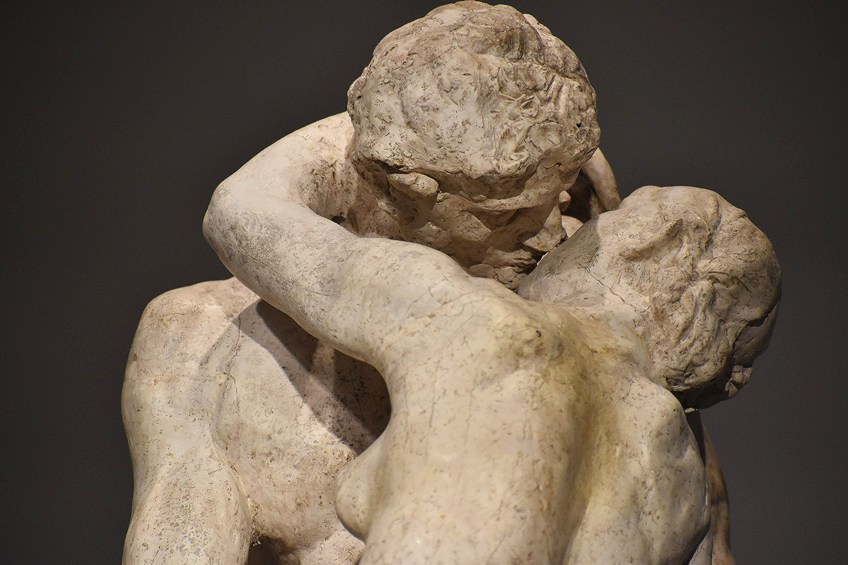
Secondly, the fact that there is no actual kiss ties in with the story of Francesca and Paolo. In Dante’s Divine Comedy, Dante is led through the nine levels of hell by the Roman poet Virgil. Each level of hell is reserved for those that commit a particular crime. When they reach the second circle of hell, they bear witness to all of the souls sent to hell for committing adultery, amongst which are Francesca and Paolo.
As punishment for their sins, their souls are blown around in a perpetual storm of lust, forever searching for their lovers.

Auguste Rodin Sculptures Are Never Life-Sized
In 1875, Rodin visited Italy, where he saw many astounding works of art. He was deeply inspired by the sculptures of Michelangelo. Thus, upon returning to Belgium, he set to work on some sculptures of his own. Although it would be a few years before any were ready for exhibition. In 1877, Rodin’s The Bronze Age was debuted to the public, first in Brussels and then at the Paris Salon. The sculpture depicts a male nude with his left arm raised above his head and his right by his side. Rodin had studied his model ceaselessly and from every angle.
Thus, the statue was so realistic that Rodin was accused of using the model to make a cast, rather than actually sculpting the figure himself.

After a lot of bad press, and much scrutiny from a panel of sculptors, Rodin’s name was finally cleared. However, criticisms surrounding The Age of Bronze never fully dissipated. Thus, Rodin swore to never create another life-sized statue. Every one of his proceeding works was either smaller or larger than life-sized.
Therefore, although there are multiple versions of “The Kiss” by Auguste Rodin of varying sizes, each one is purposefully larger than life-sized in order to avoid scandal.
An Application Had to Be Made Before Viewing The Kiss
In 1893, a bronze cast of The Kiss by Auguste Rodin was shipped to the United States to be displayed at the World’s Columbian Exposition. The exposition was held in celebration of 400 years since Christopher Columbus’ arrival in North America. It was a colossal event that displayed art, music, and architecture from all over the world.
During the six months, it ran it received more than 27 million visitors.
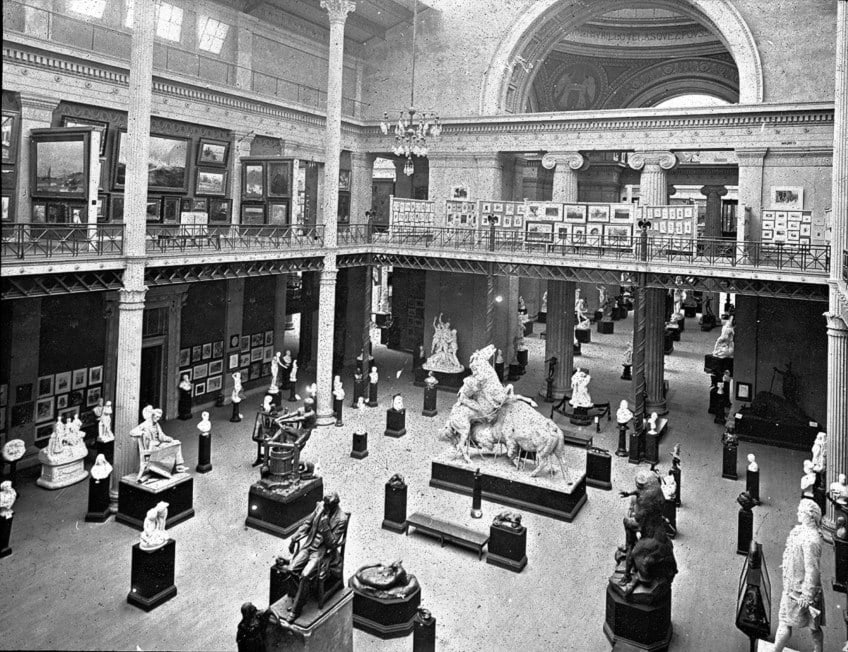
Although The Kiss was part of the extensive exhibition, one could not simply attend the event and see the sculpture. Instead, special permission had to be granted in order for a visitor to gain entrance into the room in which it was kept.
This was due to the erotic nature of the statue.
The organizers did not think it appropriate for the general public. Although other nudes were displayed at the exposition, the risqué position of the nudes in The Kiss, as well as the clear portrayal of female sexuality, was considered highly controversial.
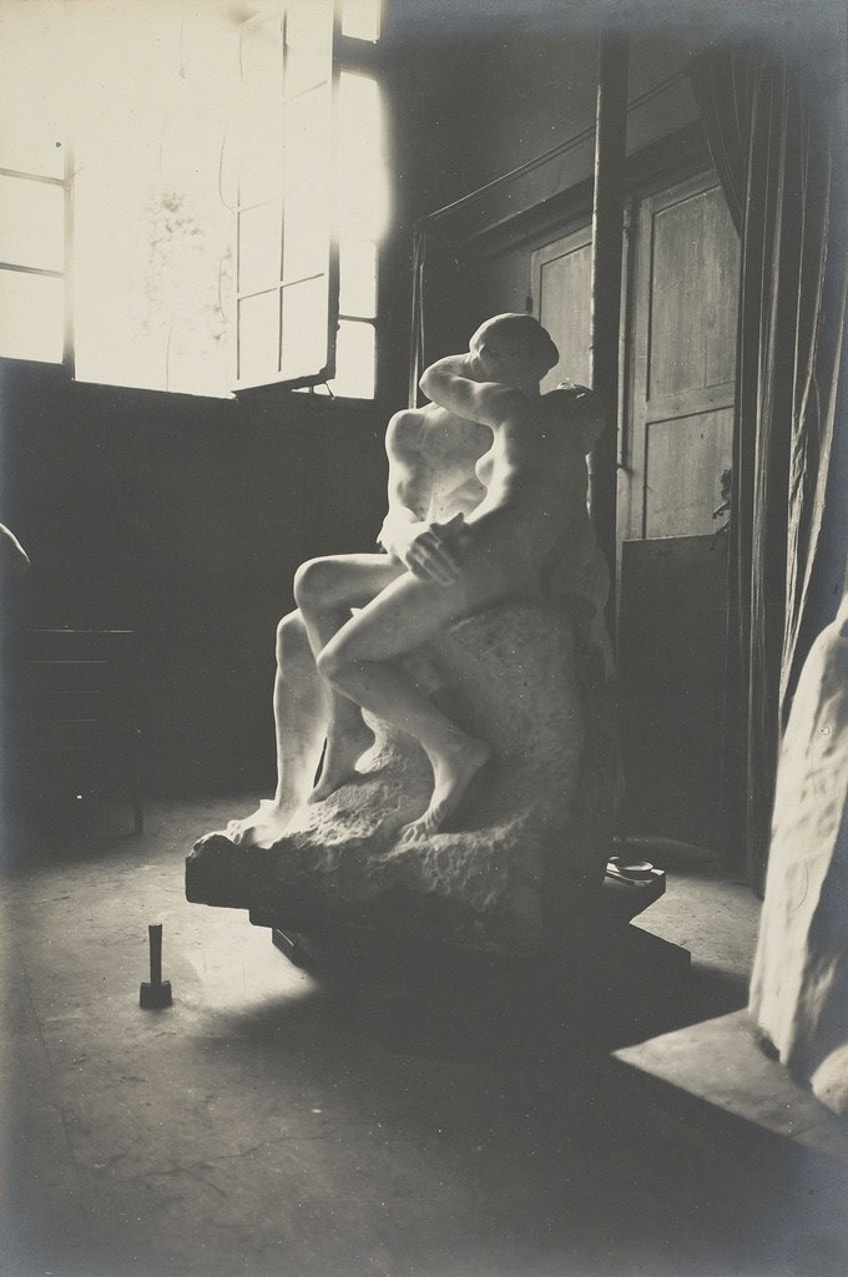
The Female Nude Is Thought to Be Modeled After Camille Claudel
In 1883, Rodin met the young and talented artist Camille Claudel whilst teaching a sculpting workshop. Rodin was impressed with her artistic skills and so took her under his wing. The two artists soon entered into a love affair, even though Rodin’s primary partner was the mother of his child, Rose Beuret. Claudel was not Rodin’s first mistress, but she was certainly his most passionate.
During the 15 years of their tempestuous romance, Rodin created some of his most brilliant works, including “The Kiss”.
Claudel was a very sensual woman and often acted as his model and his muse for sculptures. Many believe that Rodin saw parallels between Claudel and the character of Franchesca in Dante’s Inferno, as they were both passionate, rebellious women. Thus, Claudel and Rodin’s enchantment with her will forever be immortalized in The Kiss.

Auguste Rodin did not have the smoothest career as an artist. It took many years of backbreaking work, scandal, and rejection before he achieved the reputation that he has today. However, he persevered and is now one of the most famous sculptors in the world. His works such as “The Kiss” are iconic and will likely continue to be indefinitely.
Frequently Asked Questions
What Was Auguste Rodin Best Known For?
Rodin had many sculptures which became internationally famous. He was also lucky enough to have witnessed his success during his lifetime, a fate not always afforded to great artists. Some of Rodin’s most famous works include The Age of Bronze (1877), The Thinker (1880), The Kiss (c. 1882), and The Gates of Hell (1917). Originals, as well as replicas made from his casts, can be found all over the world in cities such as Paris, London, Tokyo, and Philadelphia.
What Art Style Is Rodin’s The Kiss?
Rodin is known for his incredibly realistic portrayals of the human form. So much so that he faced a great deal of controversy as many believed that he was using a model to form his casts. For this reason, the majority of his sculptures are either smaller or larger than life-sized. This Realism is clearly evident in The Kiss. Rodin is also considered to be an Impressionist. This is primarily due to his depiction of ordinary subject matter, something quite unusual in sculpture at the time. His works were also highly emotive and had an air of spontaneity. This is due to Rodin’s preference for a more raw, unrefined appearance in his art.

Emma completed her Bachelor’s Degree in International Studies at the University of Stellenbosch. She majored in French, Political Science, and History. She graduated cum laude with a Postgraduate Diploma in Intercultural Communication. However, with all of these diverse interests, she became confused about what occupation to pursue. While exploring career options Emma interned at a nonprofit organization as a social media manager and content creator. This confirmed what she had always known deep down, that writing was her true passion.
Growing up, Emma was exposed to the world of art at an early age thanks to her artist father. As she grew older her interests in art and history collided and she spent hours pouring over artists’ biographies and books about art movements. Primitivism, Art Nouveau, and Surrealism are some of her favorite art movements. By joining the Art in Context team, she has set foot on a career path that has allowed her to explore all of her interests in a creative and dynamic way.
Learn more about the Art in Context Team.
Cite this Article
Emma, Littleton, ““The Kiss” Sculpture by Auguste Rodin – Analyzing Rodin’s “The Kiss”.” Art in Context. June 3, 2022. URL: https://artincontext.org/the-kiss-sculpture-by-auguste-rodin/
Littleton, E. (2022, 3 June). “The Kiss” Sculpture by Auguste Rodin – Analyzing Rodin’s “The Kiss”. Art in Context. https://artincontext.org/the-kiss-sculpture-by-auguste-rodin/
Littleton, Emma. ““The Kiss” Sculpture by Auguste Rodin – Analyzing Rodin’s “The Kiss”.” Art in Context, June 3, 2022. https://artincontext.org/the-kiss-sculpture-by-auguste-rodin/.


